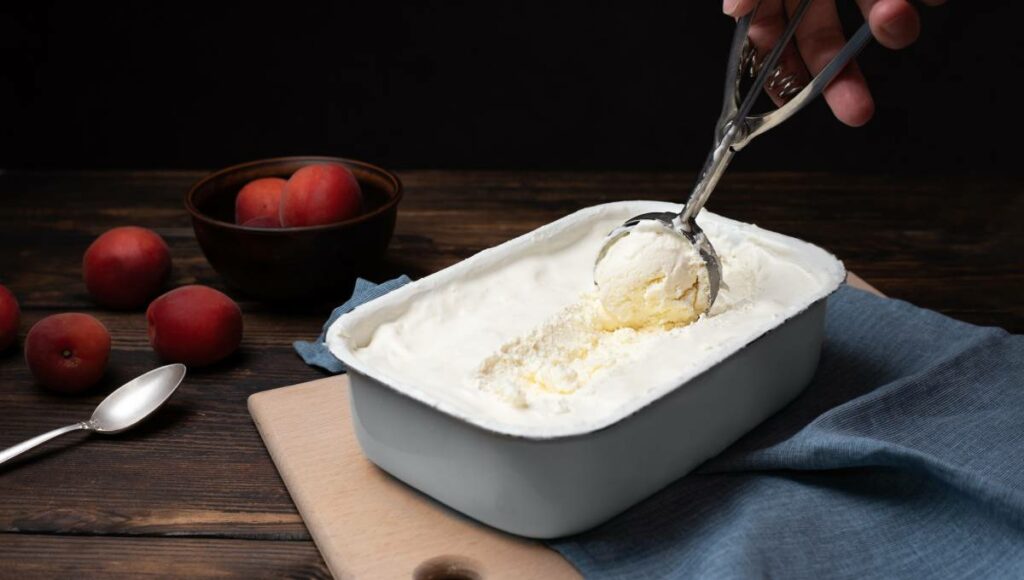Share the post "Are Ice Cream Containers Microwave Safe? (how to tell)"
We’ve all done it—popped the ice cream in the microwave for 10 to 20 seconds to let it melt just a tad and make it easier to scoop out into a bowl (or directly into our mouths!). But are ice cream containers actually safe to microwave?
Generally, yes, ice cream containers are safe to microwave. However, whether a container is safe to microwave depends on the material(s) it’s made from. Most plastic ice cream containers are made with polypropylene, and most paperboard containers are coated with polyethylene plastic, both of which are microwave-safe.

How do I know if a plastic ice cream container is microwave safe?
To see if a container is safe to use in the microwave, you need to find out what material it’s made from. Firstly, is the container plastic or paperboard?
If it’s plastic, you need to know what it is—there are various types of plastic, and not all types of plastic are microwave safe. Fortunately, it’s usually easy to find out which plastic a container is made from.
If you look at the bottom of the container you should see a number in the middle of a triangle—this number is a code for the type of plastic that was used to make it. Here’s what those numbers mean and whether that type of plastic is microwave safe or not:
- #1: Polyethylene terephthalate—it is not microwave-safe.
- #2: High-density polyethylene—it is microwave-safe.
- #3: Polyvinyl chloride—it is not microwave-safe.
- #4: Low-density polyethylene—microwave-safe only if the manufacturer states so.
- #5: Polypropylene—it is microwave-safe.
- #6: Polystyrene—it is not microwave-safe.
- #7: Other—microwave-safe only if the manufacturer states so.
So, if the ice cream container is made from high-density polyethylene (#2) or polypropylene (#5), you can safely put it in the microwave.
If it’s made from low-density polyethylene (#4) or an unspecified “other” type of plastic (#7) you can only safely microwave if the manufacturer has explicitly written this on the packaging. Any other sort of plastic is not microwave-safe.
How do I know if a paperboard ice cream container is microwave safe?
Some ice cream containers, such as the popular Ben & Jerry’s brand, are made with paperboard. This is a resilient form of paper. However, paperboard is not waterproof and so manufacturers must coat the inside of the container with a thin layer of plastic so that the precious ice cream inside doesn’t seep through the paperboard.
To know if your paperboard ice cream container is microwave-safe you need to find out which type of plastic was used to coat the inside.
As mentioned, most paperboard ice cream containers (such as Ben & Jerry’s) are coated with polyethylene—this type of plastic is microwave-safe.
To be sure of the material your paperboard ice cream container is coated with, you’ll need to check via the brand’s website.
Should I microwave ice cream in its container?
Now you know whether your ice cream container is microwave-safe or not—or at least how to find out this information. But is it a good idea to microwave ice cream first? That depends.
A big reason why ice cream is so loved across the world is its silky soft texture. But did you know that melting and re-freezing ice cream permanently changes that texture?
Have you ever eaten ice cream that felt kind of…rough and almost crunchy on the tongue? You were probably eating ice cream that melted and was frozen once again. When this happens, the ice crystals in the ice cream permanently change shape to be larger, affecting the texture.
If you’re going to eat the entire container of ice cream after microwaving it (no shame in that), then there shouldn’t be a problem. But if you intend to stick it back in the freezer after scooping a serving out, you may wish to keep your ice cream away from the microwave.
Final Words
The answer to the question ” are ice cream containers microwave safe? ” is yes, they usually are. Most plastic ice cream containers are safe to microwave, but you should always check what kind of plastic the container is made from to be sure of this.
Most paperboard ice cream containers use a type of plastic coating that is also microwave-safe but to be sure, you should try to find out the exact type of plastic coating that the manufacturer used to make the container by checking on their website.

